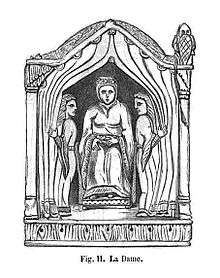Ferz
A ferz (or fers) is a fairy chess piece that moves like a bishop, but can only go one square.[1] The ferz can move one square diagonally in any direction. In this article, the ferz is represented by an inverted bishop.
History and nomenclature

The ferz is a very old piece, appearing in the ancestor of all chess variants chaturanga and shatranj as well as some very early chess variants, such as Tamerlane chess. The advisor in xiangqi moves like a ferz, but has additional restrictions involving where it can move. The ferz was a standard chess piece until the modern moves of queen and bishop were developed around 1300 CE. It also appears in some large historical shogi variants, such as dai shogi, under the name "cat sword" (猫刄 myōjin).
The Thai variant of chess, makruk, retains the ferz from shatranj as the "Met", both as a starting piece and as the only pawn promotion option. Thus, much of shatranj endgame theory is also valid for makruk.
The piece was originally called the mantri (Sanskrit for "minister" or "counsellor"), which was translated by the Persians to farzin, which means "counsellor" or "wise man". This was shortened by the Arabs to firz, and this became ferz or fers in Medieval Europe. Its name later changed to queen, but when that name started being used for the modern chess queen, its former name ferz or fers began to be used in chess problems. In Russian and Ukrainian, however, ferz (ферзь) is the current name for the chess queen.
Value
The ferz by itself is worth about half a knight. Three ferzes and a king can force checkmate on a bare king, if all three ferzes are not on the same color squares; two ferzes and a king can force stalemate on a bare king, but not easily. The endgame of rook versus ferz is a win for the rook. Despite being colorbound, the ferz is the strongest of the basic leapers during the opening phase of the game, even stronger than the wazir, because it has larger mobility forward. A wazir and a ferz can only force checkmate on a bare king, if the bare king is significantly close to a corner that is the same color as the ferz. Two ferzes cannot force checkmate, whether they are on the same color or not. Two wazirs cannot force checkmate. A knight and wazir can force checkmate against a bare king, but a knight and ferz can only do so if the bare king is significantly close to a corner that is the same color as the ferz. The wazir is better than the ferz in most endgames, because of the wazir's ability to restrict squares adjacent to the squares last restricted.
References
Bibliography
- Dickins, Anthony (1971) [Corrected repub. of 1969 2nd ed., The Q Press, Richmond, Surrey, England]. A Guide to Fairy Chess. New York: Dover Publications Inc. ISBN 0-486-22687-5.